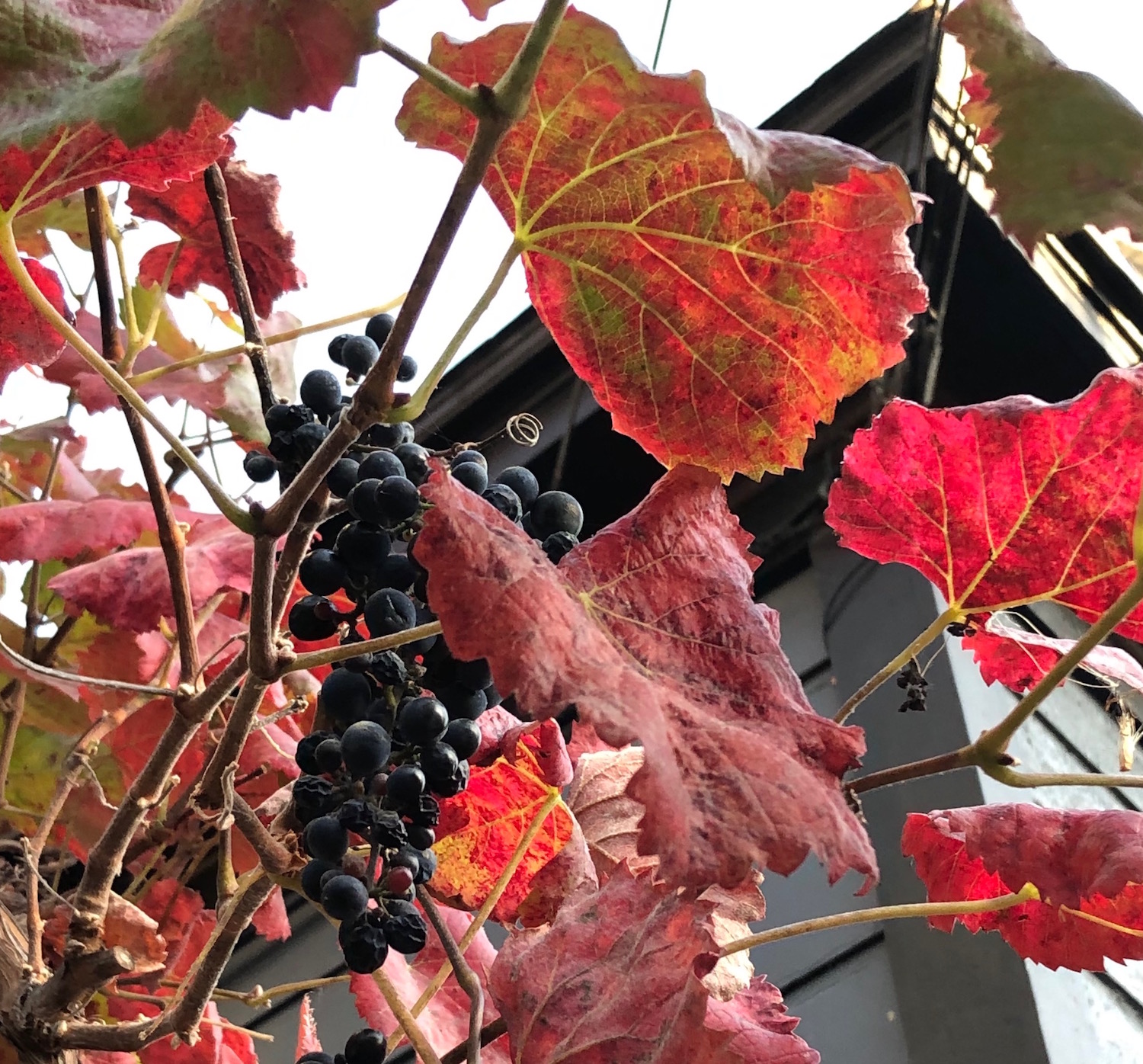
Each year at Thanksgiving time I enjoy the flaming foliage on the ‘Roger’s Red’ grape. This locally popular vine was originally wild collected by Roger Raiche in Sonoma County in the fall of 1983. Initially Raiche guessed it to be a variant of the California wild grape Vitis californica. The dominant fall color on the wild grape is yellow. So the story as Raiche tells it in an article in Pacific Horticulture Magazine (Oct. 2011) is that he noticed the bright red color of the vine in “high quality native habitat” four miles from the nearest vineyard. He collected some cutting material and brought it back to the UC Botanical Garden were he was in charge of the native plant collection. From the UCBG and Tilden Botanical Garden sales, the vine became widely used for visual interest. The question of wether this clone was a true native was discussed along that timeline until the advent of genetic sequencing. In 2007 the cultivated grape Vitis vinifera and the California wild grape Vitis californica were genetically sequenced and compared. As a result it became clear that “the genotype of ‘Roger’s Red’ was not fully consistent with either species, but contained elements of both, suggesting that it was, as suspected, a hybrid.”(PH10:2011). This is interesting because even though the originally collected ‘Roger’s Red’ grape was from an intact wild area four miles from the nearest vineyard – a cross occurred. Given that in 2018 there were 925,000 acres of grape (V. vinifera) in cultivation for wine, raisins and table grapes throughout the state (CDFA, April 2019) it seems likely that lots of hybridization happens. It is now known that a red grape (V. vinifera ‘Alicante Bouschet’) used to add deep color to red wine, crossed with the native wild grape to give us the “spectacular crimson display that made ‘Roger’s Red’ so distinctive in autumn”.
The wild plant is usually seen in canyons and along water courses climbing up trees or covering the ground with twisted, woody ropes of vine. In late spring large red tinged buds break open and the plant suddenly seems to be in a great hurry, rapidly growing stems and getting ready to flower. New stems push out large rounded to lobed bright green leaves covered in a fuzz which wears thin over time. Clusters of tiny green flowers are pollinated by small wasps and sweat bees. Once the flowers are pollinated, fruit ripens under a dense canopy. The vine on the front fence of the nursery cascades over a chainlink fence topped with razor wire, the fruit is well guarded deep within the tangle of armored wire and thicketed vine, perfect cover for the resident gang of very vocal white crowned sparrows. California wild grape produces small seedy but edible purple fruit with a white blush.
In the garden whether you end up with a genetically native, accidental hybrid or intentionally selected plant  – this deciduous perennial vine is easy to grow. Left to its own devises it can cover a fence or a trellis in one season. After establishment it can take little to no summer water though it will tolerate irrigation. Restricting the amount of summer water your grape vine gets can help slow down its exuberant growth. Grapes tolerate a wide range of heavy soils and prefer full sun, stretching up through tree canopies to reach light.
– this deciduous perennial vine is easy to grow. Left to its own devises it can cover a fence or a trellis in one season. After establishment it can take little to no summer water though it will tolerate irrigation. Restricting the amount of summer water your grape vine gets can help slow down its exuberant growth. Grapes tolerate a wide range of heavy soils and prefer full sun, stretching up through tree canopies to reach light.
The amount of fruit your vine produces depends upon the age of the stems. The third year after I planted my first ‘Rogers Red’ vine (back in the early aughts) my family and I harvested bowl after bowl blue black clusters and made several batches of Very Grape Jelly. On older vines that have not been cut back or pruned, fruit is scarce. Fruit is produced on one year old canes. At the nursery in the last two seasons we have been able to please the birds by heavy pruning. Right now the vine is in full color though the recent cold storms are sure to signal time for leaf drop. The cycle of dormancy, spring bud break, leaf, flower, fruit will begin again and for that I am thankful.